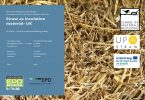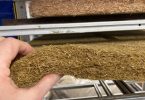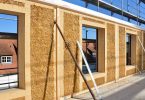Agricultural production leaves behind it a considerable amount of agricultural waste. Some of these are reused in agriculture as fertilizer, but most are burned. Uncontrolled burning is a solution with a negative impact on the environment and energy waste. Straw is a healthy alternative to modern construction materials, being a natural material.
While prices of construction materials have increased in recent years, agricultural waste recycling presents a continuous challenge for the fields of engineering, attention being directed to the materials made from agricultural waste showing characteristics similar to the traditional production, at a considerably lower price. Straw bales have demonstrated standard insulation capacity two times better than that required by regulations, with power consumption reduced by 50%. At the same time, the straw bales significantly reduce the energy consumed to build a wall by up to 90%. Globally, the construction of straw bale is rising. In many countries governments encourage the use of straw in the construction industry; local authorities are among the biggest beneficiaries. In Romania, natural and greenhouses are becoming increasingly popular and more and more specialists are interested in this type of construction.
Authors: CANTOR, Dana Maria; MANEA, Daniela Lucia; 8.3.2015







